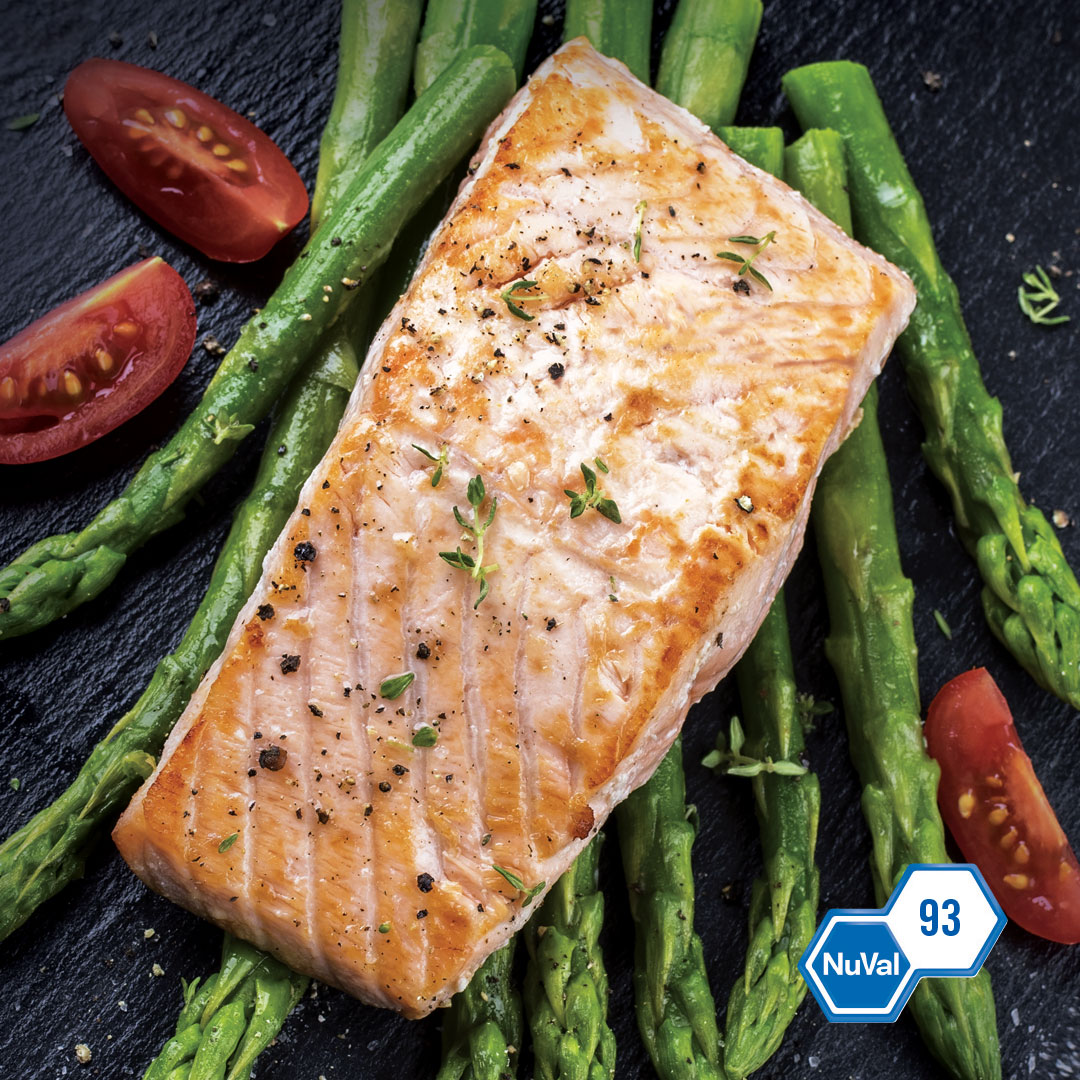Written by Ellie Wilson, MS, RDN Senior Nutritionist

Fish and seafood continue to gain fans and favor with health organizations around the world. Seafood twice per week benefits heart and mind, so I am sharing some get-you-there guidelines to make it easy. We have highlighted these benefits by ages and stages –time to get everyone to the table for delicious, nutritious seafood.
Most seafood is high in lean protein, omega 3 fatty acids and other important nutrients, like selenium. NuVal® Nutrition Scores at Price Chopper and Market 32 confirm this –most seafood scores 90 and above. Look for the blue score on the case and shelf tags.
Ages and Stages
Pregnant Mom, preterm infant: The USDA guideline is 8 – 12 oz. of fish and seafood per week. This is a great way to boost infant brain development – the omega 3’s from seafood are important to development.
Young child – Mild taste and easy, quick prep make seafood a great idea for busy parents. Fish sticks or fish bites are easy to make and fun finger food. Bonus – kids get more omega 3’s in a lean protein package.
Tweens and teens – Keep seafood on the plate as tweens and teens start to pay more attention to their food. Seafood is super easy to season and cook – quick and versatile, they can make dinner for everyone in just a few minutes! Launch a great food habit they will enjoy and that will protect their health across their whole lifespan.
Adults – Seafood twice per week protects heart and mind – shown to reduce risk of some cardiac disease, and also to support memory as we age.
Remember to eat seafood twice per week.
Winner, winner, seafood dinner! Recipe tip – most seafood recipes are very versatile, and you can switch out or swap in your choice instead of the recipe item. Trying to plan a quick and easy meal? Consider the Create, Take and Bake seafood meals at the Price Chopper seafood counter – your choice of 4 different fish or shrimp, fresh cut veggies and seasoned to order in a steam-at-the-store or bake-at-home self-contained package. Great meal, no muss, no fuss! Or, enjoy these great recipes you can make with and for friends and family. Learn more about seafood at
www.seafoodnutrition.org.
https://www.pricechopper.com/recipes/8097/Smoked-Paprika-Roasted-Salmon-with-Wilted-Spinach
http://www.seafoodnutrition.org/mediterranean-tuna-salad.html
https://www.pricechopper.com/recipes/7366/Shrimp-Party-Dip

February is American Heart Month, and we are inspired to enjoy some delicious recipes that showcase pears. Winter fruit intake is so important to heart health, especially fruit in season – pears fit the bill. Certified by the American Heart Association, pears add Vitamin C and fiber to your heart smart cart, and complements so many foods.
A little history – pears have long been lauded for their sweetness – the description “gift of the Gods” was coined in Roman times. Pears were excellent travelers, and made their way around the world on traditional travel routes. In America, they landed on the Eastern shores and then made their way via the Lewis and Clark trails to the Pacific Northwest. Pear production in those states is over 550,000 bushels per year, and the pear is officially Oregon’s state fruit.
Pears have had some excellent research show they are a very good choice for vascular health – pears, along with other white-fleshed produce, were shown to reduce risk of stroke in the Women’s Health study. Stroke 2011;42:00-00 The median intake of white-fleshed produce, including pears, apples, and vegetables, showed that each increase of 25 grams (over base intake of 118 grams per day) lowered risk of stroke by 9%. Powerful results!
Enjoy some wonderful winter recipes that include pears – check these out, and find more at the USApears.org website. Remember to check the neck for slight give – that shows it is ripe for a delicious snack or recipe.
http://usapears.org/recipe/hearty-oatmeal-with-pears/
Tangy Pear and Cabbage Slaw
Written by Maureen Murphy

Although it’s the season for holiday parties and special meals it’s also the season when many people find themselves gaining an extra 5-7 lbs. from overindulging in sweets, dips, and more. With a few simple tips and modifications your guests will still enjoy the party and their hips will thank you come January!
Simple tips & cooking modifications:
- Serve veggies, pretzels, or baked pita chips for dipping instead of potato chips
- Serve shrimp cocktail and a veggie tray for lighter snacks
- Use low fat or nonfat dairy products to replace higher fat counterparts
- Serve whole grains – breads, rolls, pasta, etc.
- Flavor roasts and vegetables with fresh herbs and a little grated Parmesan cheese instead of butter and/or salt
- Roast meats and poultry on a rack in a roasting pan
- Skip the gravy entirely or at least skim fat off (every tablespoon of fat discarded amounts to 120 calories and 13 grams of fat)
- Use fat free milk or reduced sodium chicken broth when making mashed potatoes, and add garlic and herbs to enhance the flavor

- Season vegetables with herbs, spices, balsamic vinegar and/or lemon juice instead of butter or heavy sauces
- Reduce sugar called for in a recipe by a third
- Substitute an equal amount of applesauce or prune puree for at least half the oil, margarine, or butter in baked good recipes
- Substitute a graham cracker crumb pie crust for the traditional pastry crust, and use half the butter or margarine called for in the crumb crust recipe, adding a little liquid to moisten if too dry
- Have water or diet soda available for guests to choose instead of higher calorie and sugar beverages like alcohol, soda or juice
- Skip dessert and serve fresh fruit for a light end to the meal
Written by Ellie Wilson, MS, RD Senior Nutritionist
Many people are on a budget these days and that tends to raise awareness of all kinds of things, including how much food we eat. For those managing diabetes, being aware of food and what its impact is on blood sugar is important, but more than once I have heard that eating healthfully is too expensive. Balancing the budget and balancing health is possible, with a few insights and a little planning.
Planning is the first hurdle – so many of us are so busy, we find it easy to ignore the concept. However, most of us plan “accidentally” – many people have a set routine for meals they cook throughout the week, as well as typical items they buy or prepare for lunch, dinner and snacks. It often changes seasonally – salads in summer, with meat on the grill; soup in the fall and winter, as well as crockpot meals. The first step to planning is just putting your “usual’s” down on paper, with dollar amounts you usually spend (or the budget amount you are trying to stick to!)
You don’t have to change everything to eat healthier on a budget, just tweak what you usually do. Do you buy rotisserie chicken for Monday nights, when you don’t want to cook? Plan on scooping out some frozen broccoli from a bag in the freezer, and microwaving a small potato – done, healthy, fast, and cheap. Both the frozen broccoli (as well as any other frozen vegetable or fruit) and the potato are very economical choices for eating well. Try a little herb seasoning, lemon or ginger in the cooking water of the broccoli.
Breakfast is also easy – eggs are a really inexpensive source of good protein, and easy to mix up with leftover vegetables for an omelet. Wheat bread is the new white bread – we now eat more wheat bread than white in the U.S., so it should be easy to find an economical choice that has at least 2 grams of fiber per slice.
Manage meat – check on the sales, slice thinly, store leftovers properly, and you can probably turn down the volume but

turn up the lean, more nutritious protein choices – trade up to seafood and lean meats. Coupons are also a tool in your toolbox – check out that list of usual’s every week, and connect coupons where you can – you’ll get the best nutrition as well as the best bargain!
Medication connection – check out the Price Chopper Diabetes AdvantEdge program. Multiple medications, insulin syringes, pen tips, lancets and lancing devices – are all free. That will definitely lower the cost of diabetes management! Here is a great
EatingWell® recipe that puts it all together – enjoy!
 Fish and seafood continue to gain fans and favor with health organizations around the world. Seafood twice per week benefits heart and mind, so I am sharing some get-you-there guidelines to make it easy. We have highlighted these benefits by ages and stages –time to get everyone to the table for delicious, nutritious seafood.
Most seafood is high in lean protein, omega 3 fatty acids and other important nutrients, like selenium. NuVal® Nutrition Scores at Price Chopper and Market 32 confirm this –most seafood scores 90 and above. Look for the blue score on the case and shelf tags.
Ages and Stages
Pregnant Mom, preterm infant: The USDA guideline is 8 – 12 oz. of fish and seafood per week. This is a great way to boost infant brain development – the omega 3’s from seafood are important to development.
Young child – Mild taste and easy, quick prep make seafood a great idea for busy parents. Fish sticks or fish bites are easy to make and fun finger food. Bonus – kids get more omega 3’s in a lean protein package.
Tweens and teens – Keep seafood on the plate as tweens and teens start to pay more attention to their food. Seafood is super easy to season and cook – quick and versatile, they can make dinner for everyone in just a few minutes! Launch a great food habit they will enjoy and that will protect their health across their whole lifespan.
Adults – Seafood twice per week protects heart and mind – shown to reduce risk of some cardiac disease, and also to support memory as we age. Remember to eat seafood twice per week.
Winner, winner, seafood dinner! Recipe tip – most seafood recipes are very versatile, and you can switch out or swap in your choice instead of the recipe item. Trying to plan a quick and easy meal? Consider the Create, Take and Bake seafood meals at the Price Chopper seafood counter – your choice of 4 different fish or shrimp, fresh cut veggies and seasoned to order in a steam-at-the-store or bake-at-home self-contained package. Great meal, no muss, no fuss! Or, enjoy these great recipes you can make with and for friends and family. Learn more about seafood at www.seafoodnutrition.org.
https://www.pricechopper.com/recipes/8097/Smoked-Paprika-Roasted-Salmon-with-Wilted-Spinach
http://www.seafoodnutrition.org/mediterranean-tuna-salad.html
https://www.pricechopper.com/recipes/7366/Shrimp-Party-Dip
Fish and seafood continue to gain fans and favor with health organizations around the world. Seafood twice per week benefits heart and mind, so I am sharing some get-you-there guidelines to make it easy. We have highlighted these benefits by ages and stages –time to get everyone to the table for delicious, nutritious seafood.
Most seafood is high in lean protein, omega 3 fatty acids and other important nutrients, like selenium. NuVal® Nutrition Scores at Price Chopper and Market 32 confirm this –most seafood scores 90 and above. Look for the blue score on the case and shelf tags.
Ages and Stages
Pregnant Mom, preterm infant: The USDA guideline is 8 – 12 oz. of fish and seafood per week. This is a great way to boost infant brain development – the omega 3’s from seafood are important to development.
Young child – Mild taste and easy, quick prep make seafood a great idea for busy parents. Fish sticks or fish bites are easy to make and fun finger food. Bonus – kids get more omega 3’s in a lean protein package.
Tweens and teens – Keep seafood on the plate as tweens and teens start to pay more attention to their food. Seafood is super easy to season and cook – quick and versatile, they can make dinner for everyone in just a few minutes! Launch a great food habit they will enjoy and that will protect their health across their whole lifespan.
Adults – Seafood twice per week protects heart and mind – shown to reduce risk of some cardiac disease, and also to support memory as we age. Remember to eat seafood twice per week.
Winner, winner, seafood dinner! Recipe tip – most seafood recipes are very versatile, and you can switch out or swap in your choice instead of the recipe item. Trying to plan a quick and easy meal? Consider the Create, Take and Bake seafood meals at the Price Chopper seafood counter – your choice of 4 different fish or shrimp, fresh cut veggies and seasoned to order in a steam-at-the-store or bake-at-home self-contained package. Great meal, no muss, no fuss! Or, enjoy these great recipes you can make with and for friends and family. Learn more about seafood at www.seafoodnutrition.org.
https://www.pricechopper.com/recipes/8097/Smoked-Paprika-Roasted-Salmon-with-Wilted-Spinach
http://www.seafoodnutrition.org/mediterranean-tuna-salad.html
https://www.pricechopper.com/recipes/7366/Shrimp-Party-Dip
 February is American Heart Month, and we are inspired to enjoy some delicious recipes that showcase pears. Winter fruit intake is so important to heart health, especially fruit in season – pears fit the bill. Certified by the American Heart Association, pears add Vitamin C and fiber to your heart smart cart, and complements so many foods.
A little history – pears have long been lauded for their sweetness – the description “gift of the Gods” was coined in Roman times. Pears were excellent travelers, and made their way around the world on traditional travel routes. In America, they landed on the Eastern shores and then made their way via the Lewis and Clark trails to the Pacific Northwest. Pear production in those states is over 550,000 bushels per year, and the pear is officially Oregon’s state fruit.
Pears have had some excellent research show they are a very good choice for vascular health – pears, along with other white-fleshed produce, were shown to reduce risk of stroke in the Women’s Health study. Stroke 2011;42:00-00 The median intake of white-fleshed produce, including pears, apples, and vegetables, showed that each increase of 25 grams (over base intake of 118 grams per day) lowered risk of stroke by 9%. Powerful results!
Enjoy some wonderful winter recipes that include pears – check these out, and find more at the USApears.org website. Remember to check the neck for slight give – that shows it is ripe for a delicious snack or recipe.
http://usapears.org/recipe/hearty-oatmeal-with-pears/
February is American Heart Month, and we are inspired to enjoy some delicious recipes that showcase pears. Winter fruit intake is so important to heart health, especially fruit in season – pears fit the bill. Certified by the American Heart Association, pears add Vitamin C and fiber to your heart smart cart, and complements so many foods.
A little history – pears have long been lauded for their sweetness – the description “gift of the Gods” was coined in Roman times. Pears were excellent travelers, and made their way around the world on traditional travel routes. In America, they landed on the Eastern shores and then made their way via the Lewis and Clark trails to the Pacific Northwest. Pear production in those states is over 550,000 bushels per year, and the pear is officially Oregon’s state fruit.
Pears have had some excellent research show they are a very good choice for vascular health – pears, along with other white-fleshed produce, were shown to reduce risk of stroke in the Women’s Health study. Stroke 2011;42:00-00 The median intake of white-fleshed produce, including pears, apples, and vegetables, showed that each increase of 25 grams (over base intake of 118 grams per day) lowered risk of stroke by 9%. Powerful results!
Enjoy some wonderful winter recipes that include pears – check these out, and find more at the USApears.org website. Remember to check the neck for slight give – that shows it is ripe for a delicious snack or recipe.
http://usapears.org/recipe/hearty-oatmeal-with-pears/
 Although it’s the season for holiday parties and special meals it’s also the season when many people find themselves gaining an extra 5-7 lbs. from overindulging in sweets, dips, and more. With a few simple tips and modifications your guests will still enjoy the party and their hips will thank you come January!
Simple tips & cooking modifications:
Although it’s the season for holiday parties and special meals it’s also the season when many people find themselves gaining an extra 5-7 lbs. from overindulging in sweets, dips, and more. With a few simple tips and modifications your guests will still enjoy the party and their hips will thank you come January!
Simple tips & cooking modifications:

 turn up the lean, more nutritious protein choices – trade up to seafood and lean meats. Coupons are also a tool in your toolbox – check out that list of usual’s every week, and connect coupons where you can – you’ll get the best nutrition as well as the best bargain!
Medication connection – check out the Price Chopper Diabetes AdvantEdge program. Multiple medications, insulin syringes, pen tips, lancets and lancing devices – are all free. That will definitely lower the cost of diabetes management! Here is a great EatingWell® recipe that puts it all together – enjoy!
turn up the lean, more nutritious protein choices – trade up to seafood and lean meats. Coupons are also a tool in your toolbox – check out that list of usual’s every week, and connect coupons where you can – you’ll get the best nutrition as well as the best bargain!
Medication connection – check out the Price Chopper Diabetes AdvantEdge program. Multiple medications, insulin syringes, pen tips, lancets and lancing devices – are all free. That will definitely lower the cost of diabetes management! Here is a great EatingWell® recipe that puts it all together – enjoy! 

